After another pre-dawn start, we left the company of the kind folks at Bingenheimer and headed south towards Nuremberg and beyond. Our next stop: Gerhard Bohl’s home and gardens in the hamlet of Rednitzenbach. Gerhard and his wife Susanne are the brains, braun, and brilliance behind Das Sortenbuch (= the variety handbook), a mail-order catalog collection of more than 2,000 tomatoes, 380 peppers, 700 beans, and hundreds of other rare and unusual vegetables (written in German).
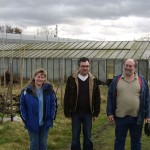
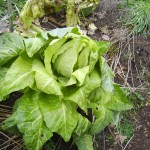
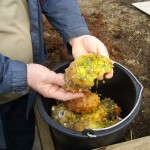
The crew: Susanne, Peter and Gerhard; Filderkraut – the ultimate Sauerkraut cabbage; Jelly melon slightly useful cucurbit.
Gerhard trades straight across with gardeners and fellow “collectioners” to the tune of some 20,000 seed packs per year. He distributes another 30,000 seed packs per year through other venues, mostly through his mail-order catalog with gardeners in other parts of Germany. Gardeners must write him by post and send five Euro for a copy of the Sortenbuch. If they decide that they want something from the buch, (how can they not?), they write again and send one Euro for every seed pack that they order, or if they are seed savers they can send in seeds from something they have grown in lieu of the cash. To encourage his customers to participate in the exchange and the stewardship of varieties, the Sortenbuch has several pages in the beginning that instruct people how to save seeds. This information is an important part of Gerhard’s work, as German-language editions of seed saving books are not common.
Gardeners that discover the Sortenbuch are often overwhelmed at the amount of varieties offered therein. Gerhard told us he recently received a letter from a man that told him he had been looking through the buch for weeks and had decided he wanted just about everything, which of course wasn’t possible considering his small garden. He requested that Gerhard just send him whatever varieties he found interesting, which is just about the only thing one can do when faced with so many options. Of course he obliged, and as he recounted this story we saw the twinkle in his eye that quickly became familiar in the short time we were there — the twinkle that we saw whenever he was thinking about vegetables. I can only guess he was imagining this man’s garden, full of the delightful varieties that he had chosen.
Gerhard and Susanne’s generosity was apparent in every interaction with us. They offered to give us whatever seed we wanted, and we found ourselves just as overwhelmed as the aforementioned correspondent. Andrew spent every free moment studying the buch (not easy considering his lack of knowledge of the German language), and developed quite a little wishlist. In the end we had to do the same as the gardener above and ask Gerhard to recommend some of his favorites. “All of them are my favorite variety. I like them all” he stated quite simply, with the twinkle in his eye, and he began suggesting, well, just about every tomato variety he could think of.
On Satuday we went for a walk to one of their gardens, where we saw Perpetual Spinach (a Beta vulgaris), Butterkohl (a golden savoy open headed cabbage), and Filderkraut (an extremely conical white cabbage traditionally used for sauerkraut). He showed us the tubers of oca (Oxalis tuberosa) and Chinese artichoke (Stachys affinis), and Jerusalem artichokes (Helianthus tuberosus). Though some of the trellises and cold frames had been damaged by the recent storm (Hurricaine Kyrill), we were able to see the potential in this winter garden. A garden in January is not generally thought of as beautiful, but walking amongst the spent plants and infrastructure is something we’ve grown quite accustomed to. Observing the overwintering crops in their dormancy has become something of a side hobby for us.
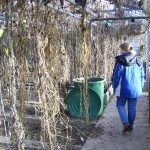
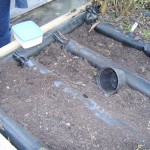
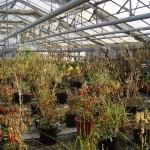
Suzanne and the last of the tomatoes: Thermal mass passive heated planting tables: last of the peppers.
Sunday morning we were off to the garden in town, where Gerhard and Susanne and friend and co-conspirator Peter Kunze grow most of their tomatoes in large glass houses rented from an elderly woman. The greenhouses house most of the 500 tomato varieties the team grow for seed every year. (Since tomato seed remains viable for many years it is not necessary to grow every variety yearly.) After the seed harvest has taken place, Peter sells the best of the heirloom tomato and pepper crop to posh restaurants in Munich, to supplement the rent for the greenhouses.
Gerhard and Susanne’s “Private Project for the Maintenance and Development of Diversity of Cultivated Plant Varieties” is really a community service project. The independent maintenance of so many varieties is quite a feat, and the price for the seed packs is so low they are practically gifting these seeds to the German-speaking world. Or German reading world. Or people that speak and read other languages but have the determination to utilize the services of Babelfish.
A copy of Das Sortenbuch can be obtained by posting a request with 10 Euro (cash) to:
Gerhard Bohl, SamenArchiv
Waldstr. 40
D-90596 Schwanstetten
Germany.
(They have moved since our 2007 visit, above is the new Address as of 2010)
Leave a Reply